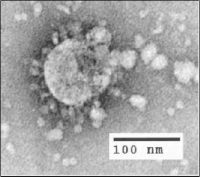
Photo from wikipedia
Dear Editor, The promptness and continuous expansion of the coronavirus disease 2019 (COVID-19) pandemic, elicited by severe acute respiratory syndrome coronavirus 2 (SARS-CoV-2) and its variants, has presented an unprecedented… Click to show full abstract
Dear Editor, The promptness and continuous expansion of the coronavirus disease 2019 (COVID-19) pandemic, elicited by severe acute respiratory syndrome coronavirus 2 (SARS-CoV-2) and its variants, has presented an unprecedented impact on human health (WHO Coronavirus (COVID-19) Dashboard, 2021). Although vaccination has attenuated the severe symptoms, there is no specific antiviral medication available for preventing the viral spread (Drayman et al., 2021). A well-documented COVID-19 case study exhibited the temporal dynamics of disease progression and related symptoms (Holshue et al., 2020), and gastrointestinal epithelial cells are susceptible to SARS-CoV-2 infection (Han et al., 2021). In order to delineate how host cell polarity regulates SARS-CoV-2 infectivity and how host genetic factors contribute to COVID-19 susceptibility, we established 3Dhuman gastric organoids for real-time imaging of cellular response to enteric infection (YaoandSmolka, 2019). In this 3D model system, enteric infection can be mimicked using intraluminal microinjection by which pathogens and their metabolites can enter the host cell via the apical membrane. Figure 1A illustrates our experimental scheme in which we compare the consequence of microinjection-based apical infection versus the typical basolateral infection with matrigel.
Journal Title: Journal of Molecular Cell Biology
Year Published: 2022
Link to full text (if available)
Share on Social Media: Sign Up to like & get
recommendations!